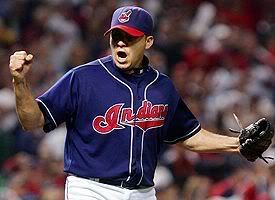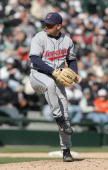 Today, we continue with our annual preview of the Cleveland Indians, and take a deeper look at the Indians bullpen for 2008.
Today, we continue with our annual preview of the Cleveland Indians, and take a deeper look at the Indians bullpen for 2008.
Part one on the starting rotation posted a few weeks back.
Flashback: By the Numbers
When you look at the Indians' bullpen numbers over the past three years, it is easy to see why the Indians enjoyed a lot of success in 2005 and 2007, but struggled in 2006. In fact, in going back and looking at the 2005 numbers, it shows how greatly underrated that collection of relievers was as they were ranked as the best in the AL by a wide margin in several categories like ERA, BAA, OPS, and WHIP. Overall, the Indians bullpen was ranked near the top in every category in 2005 and 2007, while they were ranked near the bottom in the same categories in 2006.
The Indians bullpen has also benefited from a very good starting rotation the last three years, as the ability of the starters to pitch deep into games has lessened the workload of the bullpen where they have piled up one of the lowest innings pitched totals in the league during that time. The most common constant among all three seasons is the ability to throw strikes, as their K/BB rate has been the best or near the best every year (the starters K/BB rate has been very good too). While this shows they are piling up some strikeouts, it is also a byproduct of the Indians pitch to contact philosophy to avoid walks.
Here is a breakdown of the bullpen pitching stats for the last three seasons, with AL ranks in parentheses:
| ERA | IP | BAA | OPS | WHIP | K/BB | K/9 | |
| 2007 | 3.73 (4th) | 441.1 (13th) | .254 (7th) | .707 (4th) | 1.33 (5th) | 2.51 (1st) | 8.18 (1st) |
| 2006 | 4.66 (11th) | 422.2 (13th) | .274 (11th) | .774 (11th) | 1.45 (11th) | 2.10 (5th) | 7.41 (6th) |
| 2005 | 2.80 (1st) | 446.0 (11th) | .224 (1st) | .636 (1st) | 1.13 (1st) | 2.63 (1st) | 7.22 (6th) |
| 3-YR AVG** | 3.73 (5th) | 436.2 (12th) | .251 (6th) | .706 (5th) | 1.30 (6th) | 2.41 (2nd) | 7.60 (4th) |
The 2008 Bullpen
There was very little change to the makeup of the bullpen this offseason as all of the important bullpen pieces the Indians used last season are still with the team. The entire backend of the bullpen with closer Joe Borowski, right-handed setup man Rafael Betancourt, and left-handed setup man Rafael Perez returns. Also, right-hander Jensen Lewis and left-hander Aaron Fultz will be very good middle relief options in the 6th and 7th inning. The Indians even added to the quality, experience and depth of the bullpen by signing Japanese free agent right-handed reliever Masahide Kobayashi and veteran right-hander Jorge Julio.
Right-hander Tom Mastny - who was the long man in the bullpen last year - also returns, but he is in a battle this spring with Julio, right-hander Eddie Mujica and right-hander Scott Elarton for the final spot in the bullpen. The Indians depth in their bullpen will be a strong point for them this season, as the losers from the competition for the final bullpen spot will likely be available in Buffalo, as well as some other fast rising bullpen prospects like Jeff Stevens, Reid Santos, and Randy Newsom.
One of the biggest keys to the success of any team is the performance of their bullpen. The Indians know that bullpen performance can be volatile from year to year, but they believe this can be controlled by limiting the number of innings and appearances a reliever makes in a season. The Indians also have maintained some consistency as they have several players coming back into the same roles as last year, and more importantly they have good depth to deal with any problems that arise with injuries or performance. For example, if Borowski's run of luck runs out closing games, they have several in-house closer options they can turn to in Betancourt, Kobayashi or Lewis. If Betancourt has injury issues, Lewis may be about ready to advance into the setup role. If Lewis struggles in his middle relief role, Stevens looks to be a capable replacement option as he is on the same meteoric rise in the minors as Lewis was last year.
Here is the projected Indians bullpen with a profile of each below:
CL: Joe Borowski, RHP
SU: Rafael Betancourt, RHP
SU: Rafael Perez, LHP
MR: Jensen Lewis, RHP
MR: Masahide Kobayashi, RHP
MR: Aaron Fultz, LHP
LR: Jorge Julio, RHP
Closer: Joe Borowski, RHP
| W/L | Sv | G | ERA | IP | BAA | OPS | WHIP | K/9 | K/BB | DIPS | ERA+ | |
| 2007 | 4-5 | 45 | 69 | 5.07 | 65.2 | .289 | .765 | 1.43 | 7.95 | 3.41 | 3.78 | 91 |
 When former Indians closer Bob Wickman left the Indians during the 2006 season, no one ever thought another closer would be able to walk the ninth inning tightrope the way Wickman did seemingly every night. Amazingly, the Indians found someone, and that was Borowski. Somehow, someway, Borowski had 45 saves last year, and he led the AL in saves despite the worst ERA ever for a league leader in this category. But, like Wickman, while Borowski has average stuff he relies on great composure, guts, and guile to slam the door on victories in the ninth inning.
When former Indians closer Bob Wickman left the Indians during the 2006 season, no one ever thought another closer would be able to walk the ninth inning tightrope the way Wickman did seemingly every night. Amazingly, the Indians found someone, and that was Borowski. Somehow, someway, Borowski had 45 saves last year, and he led the AL in saves despite the worst ERA ever for a league leader in this category. But, like Wickman, while Borowski has average stuff he relies on great composure, guts, and guile to slam the door on victories in the ninth inning.
In Borowski's defense, he was not as bad as his numbers indicate. His problem was that when he was bad he was usually a disaster when you consider three implosions against New York (4/19, .2 IP, 6 ER), Oakland (5/13, .2 IP, 4 ER), and Detroit (8/14, .1 IP, 4 ER). When you subtract out those three games, he actually had a good 3.22 ERA in his other 66 appearances. Borowski also put up an ERA of 4.00 or lower in every month but April (9.00) and August (7.07).
This is probably Borowski's last year with the organization as he is a free agent after the season. With a handful of in-house candidates waiting for their shot at the closer's position, Borowski is on borrowed time. In the meantime, fans will continue to have the Maalox and Pepto ready as he will be given just as many chances to slam the door on Tribe wins this season. It is probably unreasonable to expect around 45 saves again, but it should be expected that his peripheral numbers improve across the board and that he is a better pitcher overall in 2008.
Setup: Rafael Betancourt, RHP
| W/L | Sv | ERA | G | IP | BAA | OPS | WHIP | K/9 | K/BB | DIPS | ERA+ | |
| 2007 | 5-1 | 3 | 1.48 | 68 | 79.1 | .183 | .485 | 0.76 | 9.08 | 8.89 | 2.05 | 312 |
 Prior to last season, Betancourt had always been a reliable middle reliever for the Indians, but had often struggled when given the opportunity to pitch in the 8th or 9th inning. Last offseason, the Indians signed Roberto Hernandez, Keith Foulke, and Borowski to fill the setup and closer roles. When Foulke retired before spring training began, it left Borowski as the closer and Hernandez as the main setup guy. Hernandez turned out to be a disaster, and the Indians had to turn to Betancourt to fill the much needed right-handed setup man role in the 8th inning. Betancourt filled the role, and filled it he did, and now is one of the top three or four setup men in baseball. Arguably the best.
Prior to last season, Betancourt had always been a reliable middle reliever for the Indians, but had often struggled when given the opportunity to pitch in the 8th or 9th inning. Last offseason, the Indians signed Roberto Hernandez, Keith Foulke, and Borowski to fill the setup and closer roles. When Foulke retired before spring training began, it left Borowski as the closer and Hernandez as the main setup guy. Hernandez turned out to be a disaster, and the Indians had to turn to Betancourt to fill the much needed right-handed setup man role in the 8th inning. Betancourt filled the role, and filled it he did, and now is one of the top three or four setup men in baseball. Arguably the best.
Betancourt is about as reliable a reliever you will find. As an Indian, he has proven to be very durable and healthy, and he has been a very consistent, good performer in his four year Indians career from 2004-2007 never having an ERA above 3.92. Last year, Betancourt took the big step from being a good middle reliever to an elite late inning reliever. Check out how his 2007 numbers compare to his career numbers: 1.48 ERA in 2007 vs. a 2.80 career ERA, 8.89 K/BB in 2007 vs. a 4.60 career K/BB, .183 BAA in 2007 vs. .224 career BAA, and .485 OPS in 2007 vs. a .620 career OPS. And those career numbers include his 2007 season. Wow. Obviously, Betancourt is bound to take a step back or two where his numbers regress more to the mean, but if he stays healthy he should be just as dominant in the 7th and 8th innings again this year.
Betancourt signed a multi-year deal this past offseason, re-upping with the Indians for two years and $5.4 million where the Indians now control him through the 2010 season. Given he is to make $5 million in his option year in 2010, Betancourt's pay is going to push him to the closer's role very soon. He probably is already penciled in for the job next year, but could even take over closer duties sometime this season. Right now, Betancourt provides one of the best closing alternatives for any team in baseball. If Borowski has performance or health issues, Betancourt should be ready to step in and fill the closing role, which is a role he struggled with in spot duty early in his career but handled well in limited opportunities last year.
Setup: Rafael Perez, LHP
| W/L | Sv | ERA | G | IP | BAA | OPS | WHIP | K/9 | K/BB | DIPS | ERA+ | |
| 2007 | 1-2 | 1 | 1.78 | 44 | 60.2 | .187 | .530 | 0.92 | 9.20 | 4.13 | 2.85 | 259 |
 Besides Fausto Carmona, the emergence of Perez may have been the most important development of the season for the Indians last year. Without Perez anchoring the backend of the bullpen and getting tough hitters out consistently every night at crucial points in the game, the Indians may have missed the playoffs. He was unbelievable against left-handers last year, allowing only two extra base hits (both doubles) all year in 83 at bats against them, and held them to a .145 BAA and .447 OPS with 22 strikeouts. He also did a good job when coming into tough situations, where 47 of the base-runners he inherited only 8 scored.
Besides Fausto Carmona, the emergence of Perez may have been the most important development of the season for the Indians last year. Without Perez anchoring the backend of the bullpen and getting tough hitters out consistently every night at crucial points in the game, the Indians may have missed the playoffs. He was unbelievable against left-handers last year, allowing only two extra base hits (both doubles) all year in 83 at bats against them, and held them to a .145 BAA and .447 OPS with 22 strikeouts. He also did a good job when coming into tough situations, where 47 of the base-runners he inherited only 8 scored.
Perez always showed the ability to be a quality relief option when he was in the minors. For his career, in 99 career minor league games (76 starts) Perez racked up a 3.25 ERA, 2.85 BB/9, 7.14 K/9, and 1.20 WHIP. For the past two or three years, Perez had been pegged as a late inning reliever, although the Indians actually left him in the starting rotation in the minors all the way up until last season in Buffalo where he made seven starts in eight games. But, it should be noted that this was more to give Perez a better opportunity to refine his pitches and mechanics, work on controlling the running game, fielding his position, and being exposed to many different game situations. Pitching five to six innings in a game versus one inning provides better development opportunities in these areas.
Perez arguably should have been given a bullpen spot to open the season last year, but the Indians went with an approach in the bullpen to fill openings with veterans and start some of their near-ready kids in Buffalo to allow them to get the season going, relax, and be ready for a callup when needed. This approach worked beautifully last year with Perez (and Lewis), and is something they will do with the likes of Jeff Stevens and other relief prospects this year. Perez is under the Indians control through at least the 2013 season, and should be a part of the backend of the bullpen for many years to come.
Middle relief: Jensen Lewis, RHP
| W/L | Sv | ERA | G | IP | BAA | OPS | WHIP | K/9 | K/BB | DIPS | ERA+ | |
| 2007 | 1-1 | 0 | 2.15 | 26 | 29.1 | .234 | .611 | 1.23 | 10.43 | 3.4 | 2.47 | 214 |
 Lewis was a fast riser last year. Coming into last season, Lewis had pitched well as a starter going 12-10 with a 3.75 ERA in 41 games (38 starts) for short-season Single-A Mahoning Valley, advanced Single-A Kinston and Double-A Akron from 2005-2006. Even though he proved to be a quality starter, several club officials and scouts felt Lewis could be an exceptional late inning reliever if converted to the role because of his moxie on the mound, command of his pitches, his repertoire, and that his fastball would play up in a bullpen role. Lewis responded by going 3-0 with a 1.73 ERA and in 52 innings and held opposing hitters to a .177 average and struck out 61 batters while walking only 17 in 34 combined games at Akron and Triple-A Buffalo.
Lewis was a fast riser last year. Coming into last season, Lewis had pitched well as a starter going 12-10 with a 3.75 ERA in 41 games (38 starts) for short-season Single-A Mahoning Valley, advanced Single-A Kinston and Double-A Akron from 2005-2006. Even though he proved to be a quality starter, several club officials and scouts felt Lewis could be an exceptional late inning reliever if converted to the role because of his moxie on the mound, command of his pitches, his repertoire, and that his fastball would play up in a bullpen role. Lewis responded by going 3-0 with a 1.73 ERA and in 52 innings and held opposing hitters to a .177 average and struck out 61 batters while walking only 17 in 34 combined games at Akron and Triple-A Buffalo.
After only three months working in the bullpen at Akron and Buffalo, Lewis was called up to Cleveland on July 13th. The addition of Lewis to the bullpen mix in Cleveland filled a big need as the Indians were looking for a fourth reliable arm to pitch in the 7th and 8th inning. Lewis responded well, and down the stretch was incredible (0.69 ERA and .133 BAA in September) and made some big pitches against the Yankees and Red Sox in the postseason.
Lewis is another potential closer in waiting as his experience pitching in the backend of the bullpen in college at Vanderbilt University along with his makeup and abilities suit the role well. He very well could be Betancourt's 8th inning setup man as soon as late this season, but for now will be used as a stopper in the 6th and 7th inning much like Betancourt used to be prior to last season.
Middle relief: Masahide Kobayashi, RHP
| W/L | Sv | ERA | G | IP | BABIP | HR/9 | WHIP | K/9 | K/BB | DIPS | ERA+ | |
| 2007 | 2-7 | 27 | 3.61 | 49 | 47.1 | .332 | 0.76 | 1.37 | 6.65 | 2.92 | ----- | ----- |
 One of the Indians primary goals in the offseason was to improve the bullpen and add more depth and experience, and with the pickings slim in free agency and trade possibilities too costly, the Indians looked overseas. The Indians eventually settled on Kobayashi, and he ended up being the Indians biggest acquisition of the offseason when they signed him out of Japan to a two year $6 million contract.
One of the Indians primary goals in the offseason was to improve the bullpen and add more depth and experience, and with the pickings slim in free agency and trade possibilities too costly, the Indians looked overseas. The Indians eventually settled on Kobayashi, and he ended up being the Indians biggest acquisition of the offseason when they signed him out of Japan to a two year $6 million contract.
Kobayashi comes to the Indians as only the third pitcher in Japanese history with 200 or more career saves, and he is the only Japanese pitcher to save 20 or more games for seven straight seasons. While this is certainly impressive, one concern with Kobayashi is the low strikeout totals he had in Japan, and particularly how they have tailed off over the past few years.
Kobayashi certainly has the experience to handle a late inning role, but it still remains to be seen how he transitions to the game in the US. There have been many before him like Hideki Okajima of the Red Sox who made the transition well and impacted their team right away, but there have been just as many who flamed out like Shingo Takatsu did for the White Sox a few years ago. With the air of uncertainty surrounding Kobayashi, he is really the only concern in the bullpen at this point. He will be helped a lot by being given ample time to ease into his role as he will pitch primarily in the 6th and 7th inning to start the season and likely not be used in critical situations.
Middle relief: Aaron Fultz, LHP
| W/L | Sv | ERA | G | IP | BAA | OPS | WHIP | K/9 | K/BB | DIPS | ERA+ | |
| 2007 | 4-3 | 0 | 2.92 | 49 | 37.0 | .228 | .662 | 1.32 | 6.81 | 1.56 | 3.84 | 158 |
 Fultz was one of the few offseason acquisitions in the bullpen last year who stuck for the whole season, although he had mixed results on the year. He is tough to figure out as his overall numbers look good, but when you see him pitch he leaves you less than impressed. Most of this has to do with how awful he pitched last year in tight spots, particularly with the bases loaded where on three different occasions he walked in a run.
Fultz was one of the few offseason acquisitions in the bullpen last year who stuck for the whole season, although he had mixed results on the year. He is tough to figure out as his overall numbers look good, but when you see him pitch he leaves you less than impressed. Most of this has to do with how awful he pitched last year in tight spots, particularly with the bases loaded where on three different occasions he walked in a run.
Still, the veteran Fultz is a cheap second left-handed option coming out the pen and he has some value pitching in the 6th and 7th innings. Last year he was very good against left-handers, holding them to a .191 BAA and .629 OPS. One concern is how he tailed off in the second half of the season where he put up a 1.71 ERA and .153 BAA in the first half and a 4.50 ERA and .313 BAA in the second half. Fultz is not an irreplaceable part in the bullpen, so if he struggles in the first half of 2008 like he did the last half of 2007, he could be gone by the end of May. The Indians have a left-hander in Buffalo in Reid Santos they like a lot who by mid-season may be ready to fill the second left-hander role in the bullpen.
Long relief: Jorge Julio, RHP
| W/L | Sv | ERA | G | IP | BAA | OPS | WHIP | K/9 | K/BB | DIPS | ERA+ | |
| 2007 | 0-5 | 0 | 5.23 | 68 | 62.0 | .283 | .810 | 1.60 | 8.13 | 1.81 | 4.50 | 122 |
 Julio could end up being one of those bargain bin free agent signings Indians GM Mark Shapiro has become known for that may have a positive impact on the Indians this season. He started the season in Florida last year and was a train wreck as in 10 games he had a 12.54 ERA giving up 18 hits, 11 walks and 14 runs in only 9.1 innings before he was traded to Colorado in May. His season turned around in Colorado, as in 58 games he put up a 3.93 ERA, held hitters to a .256 BAA and .716 OPS, and seemed to regain his fastball command and velocity.
Julio could end up being one of those bargain bin free agent signings Indians GM Mark Shapiro has become known for that may have a positive impact on the Indians this season. He started the season in Florida last year and was a train wreck as in 10 games he had a 12.54 ERA giving up 18 hits, 11 walks and 14 runs in only 9.1 innings before he was traded to Colorado in May. His season turned around in Colorado, as in 58 games he put up a 3.93 ERA, held hitters to a .256 BAA and .716 OPS, and seemed to regain his fastball command and velocity.
After his awful 19.06 ERA month of April, he followed that up with good months the rest of the season: 2.08 in May, 1.74 in June, 5.40 in July, 3.65 in August, and 4.05 in September. One caveat with Julio is how right-handers murdered him last year, as they hit .322 with a .939 OPS against him, although one has to wonder how much that was influenced by his messy April showing.
Julio is another pitcher in the Indians bullpen who brings closing experience as he has 99 career saves. He has always been considered a good talent, but it has never really translated onto the field since his breakthrough 2002 season when he had 25 saves and a 1.99 ERA for Baltimore. Julio has often been attached to the Indians in the past with rumors they were trying to acquire him, and because of their fondness for him it seems likely Julio sticks and wins the final spot in the bullpen out of spring training.
Reserve reliever: Tom Mastny, RHP
| W/L | Sv | ERA | G | IP | BAA | OPS | WHIP | K/9 | K/BB | DIPS | ERA+ | |
| 2007 | 7-2 | 0 | 4.68 | 51 | 57.2 | .283 | .809 | 1.65 | 8.12 | 1.63 | 3.99 | 98 |
 Mastny is one of those guys who never impresses when you watch him pitch, but he often gets the job done. He will probably never be anything more than a 6th or 7th inning specialist, but for what he does he does it well and is valuable to the Indians as a depth reliever. While he will never blow anyone away with his fastball, his strength is in his ability to throw strikes. Month to month, Mastny was solid last year as he put up a 2.89 ERA in April, 2.84 ERA in May, 3.48 ERA in July, and a 3.18 ERA in August. He struggled mostly in June (11.00 ERA) and September (5.06 ERA), but really came up big in the playoffs against Boston throwing 4.2 innings of shutout relief. Mastny likely will start the season in the Buffalo bullpen and be the first bullpen callup when a need arises.
Mastny is one of those guys who never impresses when you watch him pitch, but he often gets the job done. He will probably never be anything more than a 6th or 7th inning specialist, but for what he does he does it well and is valuable to the Indians as a depth reliever. While he will never blow anyone away with his fastball, his strength is in his ability to throw strikes. Month to month, Mastny was solid last year as he put up a 2.89 ERA in April, 2.84 ERA in May, 3.48 ERA in July, and a 3.18 ERA in August. He struggled mostly in June (11.00 ERA) and September (5.06 ERA), but really came up big in the playoffs against Boston throwing 4.2 innings of shutout relief. Mastny likely will start the season in the Buffalo bullpen and be the first bullpen callup when a need arises.
Up Next: The Infielders